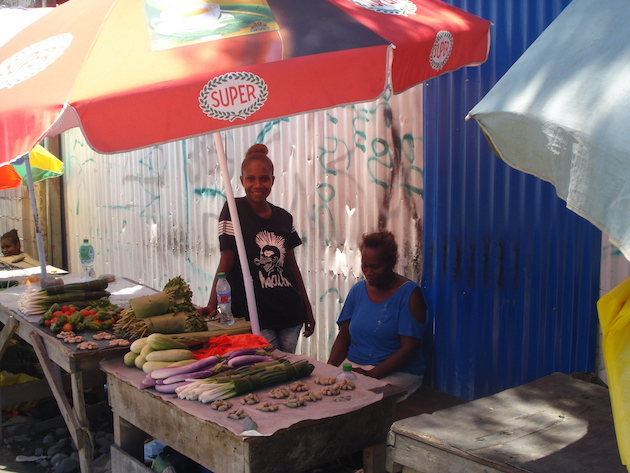HONIARA, SOLOMON ISLANDS, Nov 17 (IPS) – The Pacific Games, the most prestigious sporting event in the Pacific Islands region, will open in the Solomon Islands in the southwest Pacific on 19 November. And it is set to shine a spotlight on the energy, hopes and aspirations of youths who comprise the majority of the country’s population.
Timson Irowane (25), who has been competing in triathlons for the past six years, is brimming with confidence and anticipation. “The Pacific Games is a big event because my people are here, and it is very special because this is the first time the Solomon Islands is hosting the Games that I’ve been involved in,” Irowane told IPS during an interview at the Solomon Islands National Institute of Sport in the capital, Honiara.
Every four years, a Pacific Island nation is chosen to host the regional multi-sport Pacific Games. And this year, about 5,000 athletes from 24 Pacific Island states, such as Papua New Guinea, Kiribati, Fiji and New Caledonia, will arrive in Honiara to compete in 24 sports, ranging from athletics and swimming to archery and basketball.
The Solomon Islands has a high population growth rate of 2.3 percent and about 70 percent of the country’s population of about 734,000 people are aged under 35 years. Christian Nieng, Executive Director of the Pacific Games National Hosting Authority, told IPS that it will be a chance to showcase their talents and achievements. “It is the biggest international event ever hosted in the country. And as we are hosting, we want to compete for every medal chance,” Nieng said.
Not far from Honiara city centre, the new Games precinct includes a large national stadium, which can accommodate 10,000 people, as well as swimming and tennis centres. Eighty percent of the funding needed to build the facilities and organize the Games has been provided by international donors and bilateral partners, including Australia, New Zealand, Papua New Guinea, China, Saudi Arabia, India, Korea and Indonesia.
“One of the long-term benefits of the Games is that we now have a new sports city as a legacy of the event,” Nieng added. It will be one of the best in the Pacific region, he believes, and, if well maintained, will last for 25 years, providing world-class facilities for Solomon Islanders to pursue their development and ambitions in sport.
At the sports institute, about 1,200 athletes are in training, and their energy and excitement is palpable. Here, Irowane, who is from Western and Malaita, two outer island provinces, is one among many who are striving to be selected for the national team of about 650 athletes who will represent the Solomon Islands later this month. His dedication has already led to international success. He participated in the Pacific Games held in Samoa in 2019 and numerous regional championships before heading to the Commonwealth Games hosted in Birmingham in the United Kingdom last year.
But he said that there were many wider benefits of sport to young people. “Triathlon is a multi-sport which involves discipline. Sport is not just for training, for fitness and skills that you learn in a specific sport, but it trains holistically to be a better person and a responsible person,” Irowane said. “And it helps athletes and individuals to be good citizens.”
Another local star aiming high is 21-year-old Jovita Ambrose, also from Malaita Province. “I started athletics and running during school games when I was 17 years old. When I’m running, I know that I’m good at it. When you are good at sport, it keeps you busy; it helps you stay healthy and not get involved in negative activities, such as drugs,” Ambrose said. In the last two years, she has travelled to competitions overseas, including the World Athletics Championships in Oregon in the United States last year and in Budapest, Hungary, three months ago.

The Solomon Islands has a rural majority population that is scattered across more than 900 islands where there is often limited access to roads, basic services and employment. And the younger generation faces significant economic and development challenges. In a country which is not generating enough jobs for those of working age, the government estimates that 16,000-18,000 youths enter the employment market every year, with less than 4,000 likely to gain a secure job. Estimates of youth unemployment range from 35 percent to 60 percent.
“There is a lot of unemployment and, also, under-employment, where young people get a job opportunity which does not match their skill set. It is a real frustration for them when they are educated and still waiting for a job opportunity,” Harry James Olikwailafa, Chairman of the Solomon Islands National Youth Congress, explained to IPS. “The important issues for young people today are economic opportunities, employment opportunities and educational opportunities.”
In the last two decades, Solomon Islanders have also grappled with the aftermath of a five-year civil conflict. ‘The Tensions’, triggered by factors including urban-rural inequality, corruption and competition for land and resources, erupted in 1998 between rival armed groups representing local Guale landowners on Guadalcanal Island and internal settlers from Malaita Province. Hostilities ended in 2003, by which time many people, including children, had experienced violence, atrocities and displacement and had been deprived of education.
Morrison Filia 936) and his wife, Joycelyn (32), grew up in the aftermath of the conflict. And now, through a new entrepreneurial initiative, are aiming to help grow economic opportunities in Honiara. In August, they launched a new tourism business, Happy Isle Tours and Transfers, which offers airport transfers for visitors and tourists to hotels, as well as tours of Honiara, its history and landmarks, and excursions to World War II memorial sites on Guadalcanal Island.
“In Honiara, there are a lot of young people, and employment is a problem. So, the main idea is that we try to create this business so that we can employ more young people. We are trying to give young people opportunities,” Morrison told IPS.
They have also opened their business in time for the Games. “One of the other reasons why we started the business is that we noticed tourists and visitors coming , but they find it difficult to find transport,” Joycelyn said. “We are excited and looking forward to the Games because we are expecting more tourists. It will bring other different people to the country, and we are expecting increased bookings. I think it will also increase employment in the country and help us in our economy,” she continued.
The Pacific Games will continue for two weeks and finish on the 2 December. And like Morrison and Joycelyn, Timson Irowane has long-term goals. “I wish to be a role model, to introduce the sports and motivate more young people to be involved in any sport they are interested in. I love to encourage them because we have the advantage of the facilities here beyond the Games,” he declared.
IPS UN Bureau Report
Follow @IPSNewsUNBureau
Follow IPS News UN Bureau on Instagram
© Inter Press Service (2023) — All Rights ReservedOriginal source: Inter Press Service
Check out our Latest News and Follow us at Facebook
Original Source

